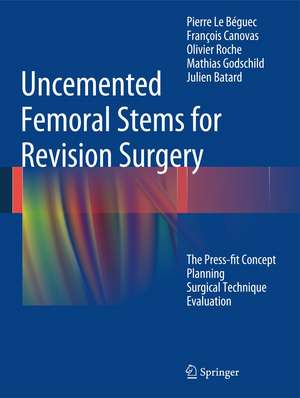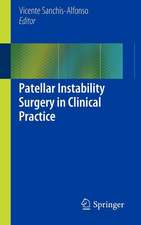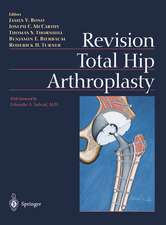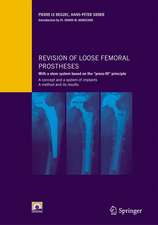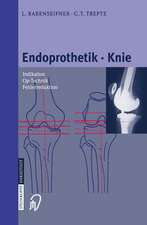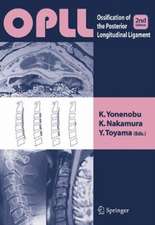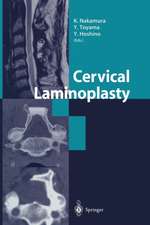Uncemented Femoral Stems for Revision Surgery: The Press-fit Concept - Planning - Surgical Technique - Evaluation
Autor Pierre Le Béguec, François Canovas, Olivier Roche, Mathias Goldschild, Julien Batarden Limba Engleză Hardback – 27 mar 2015
The quality of a surgical procedure does not depend on the manual skills of the surgeon performing it, but on how he has prepared and performed the operation “virtually” before actually performing it. This is the second step.
An operating technique must be adapted to the chosen concept and the purpose of every surgical procedure must be clearly formulated and understood by the operator. This is the third step.
Every surgeon has to have a reliable and rigorous radiological method of analysis for evaluating overall results and which suggests ways of improving results.
Preț: 724.14 lei
Preț vechi: 762.26 lei
-5% Nou
Puncte Express: 1086
Preț estimativ în valută:
138.58€ • 143.80$ • 115.83£
138.58€ • 143.80$ • 115.83£
Carte disponibilă
Livrare economică 24 februarie-10 martie
Preluare comenzi: 021 569.72.76
Specificații
ISBN-13: 9783319036137
ISBN-10: 3319036130
Pagini: 136
Ilustrații: XV, 136 p. 151 illus., 85 illus. in color.
Dimensiuni: 210 x 279 x 15 mm
Greutate: 0.63 kg
Ediția:2015
Editura: Springer International Publishing
Colecția Springer
Locul publicării:Cham, Switzerland
ISBN-10: 3319036130
Pagini: 136
Ilustrații: XV, 136 p. 151 illus., 85 illus. in color.
Dimensiuni: 210 x 279 x 15 mm
Greutate: 0.63 kg
Ediția:2015
Editura: Springer International Publishing
Colecția Springer
Locul publicării:Cham, Switzerland
Public țintă
Professional/practitionerCuprins
Part I: Press-Fit Concept.- Uncemented Concepts: Parameters to Make a Choice.- The Press-Fit Concept: Principles and Press-Fittable Zones.- The Press-Fit Concept: Practical Application.- The Press-Fit Concept: Implants And Instruments.- Part II: Preoperative Planning.- Radiographic Analysis Of The Femur.- Selection of a Strategy.- Making a Preoperative Template.- Part III: Surgical Technique.- Trochantero-Diaphyseal Femoral Flap.- Femoral Flap and Diaphyseal Primary Fixation.- Endofemoral Approach and Proximal Primary Fixation.- Part IV: Evaluation of the Radiographic Results.- General Considerations.- A-Evaluation of the Radiographic Results – How?.- Evaluation of Initial and Secondary Bone Stock.- Evaluation of Osseointegration and Secondary Stability.- Global Radiographic Score.- Comparative Elements with the Engh Score.- Part V: Evaluation of the Radiographic Results - Why?.- The Learning Curve and its Teachings.- Different Types of Primary Stability: Their Impact on the Radiographic Results.- Degree of Osteoporosis: Its Impact on the Radiographic Results.- Affected Initial Bone Stock: Its Impact on the Radiographic Results.- Parameters to Improve Radiographic Results.- Complications and Contraindications.- Numerical Evaluation and Comparative Analysis of Results.- General Conclusions: What You Should and What You Should not Do.
Notă biografică
Prof. Le Beguec served as an orthopedic surgeon and was a leading specialist in hip surgery. He has registered several patents for femoral prostheses which are now recognized and used worldwide, notably by Zimmer, a leading company in the field for the commercialization of the Revitan system.
Textul de pe ultima copertă
Choosing an uncemented femoral prosthesis means first choosing a concept and, to be effective, an operator has to have access to all the information that will allow them to reach the desired goals. This is the first step to be made.
The quality of a surgical procedure does not depend on the manual skills of the surgeon performing it, but on how he has prepared and performed the operation “virtually” before actually performing it. This is the second step.
An operating technique must be adapted to the chosen concept and the purpose of every surgical procedure must be clearly formulated and understood by the operator. This is the third step.
Every surgeon has to have a reliable and rigorous radiological method of analysis for evaluating overall results and which suggests ways of improving results.
The quality of a surgical procedure does not depend on the manual skills of the surgeon performing it, but on how he has prepared and performed the operation “virtually” before actually performing it. This is the second step.
An operating technique must be adapted to the chosen concept and the purpose of every surgical procedure must be clearly formulated and understood by the operator. This is the third step.
Every surgeon has to have a reliable and rigorous radiological method of analysis for evaluating overall results and which suggests ways of improving results.
Caracteristici
Describes the press-fit concept with planning and surgical technique The author presents a new evaluation method Numerous figures illustrate the evaluation method, which will help improve surgical interventions
